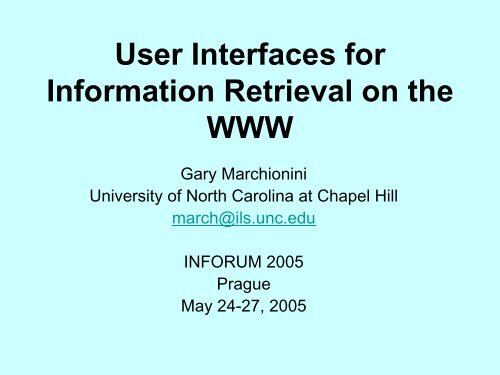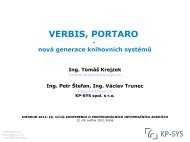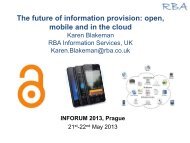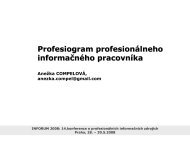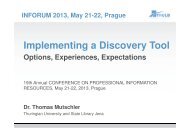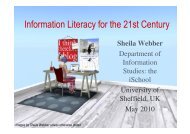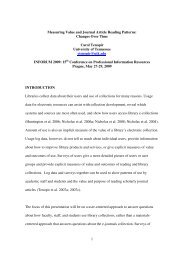DG04 project presentation - Inforum
DG04 project presentation - Inforum
DG04 project presentation - Inforum
You also want an ePaper? Increase the reach of your titles
YUMPU automatically turns print PDFs into web optimized ePapers that Google loves.
User Interfaces for<br />
Information Retrieval on the<br />
WWW<br />
Gary Marchionini<br />
University of North Carolina at Chapel Hill<br />
march@ils.unc.edu<br />
INFORUM 2005<br />
Prague<br />
May 24-27, 2005
Message<br />
• On the WWW, the User Interface is the librarian.<br />
• HCI and IR are related fields that have strong<br />
traditions that have been energized by WWW.<br />
• The intersection of these fields offers interesting<br />
new opportunities for high-impact R&D<br />
• Integrating the human and system interaction is<br />
the main design challenge: syminforosis—<br />
people continuously engaged with meaningful<br />
information<br />
Gary Marchionini, UNC-Chapel Hill INFORUM 2005
Outline<br />
• IR and the WWW<br />
• HCI and the WWW<br />
• HCIR rooted in system development<br />
• Examples<br />
– Open Video<br />
– Relation Browser<br />
• Challenges and Opportunities<br />
Gary Marchionini, UNC-Chapel Hill INFORUM 2005
Content-Centered Retrieval as Matching<br />
Document Re<strong>presentation</strong>s to Query<br />
Re<strong>presentation</strong>s<br />
Surrogates<br />
Match<br />
Algorithm<br />
Surrogates<br />
Terms<br />
Query Form A<br />
Document<br />
Space Sample Sample<br />
Query<br />
Space<br />
Vectors<br />
Query Form B<br />
Etc..<br />
Etc..<br />
A powerful paradigm that has driven IR R&D for half a century.<br />
Evaluation metric is effectiveness of the match. (e.g., recall and precision).<br />
Gary Marchionini, UNC-Chapel Hill INFORUM 2005
WWW Content Trend<br />
• Content Features (queries too)<br />
– Not only text<br />
• Statistics, images, music, code, streams, biochemical<br />
– Multimedia, multilingual<br />
–Dynamic<br />
• Temporal (e,g., blogs, wikis, sensor streams)<br />
• Conditional (e.g., computed links, recommendations)<br />
• Content Relationships<br />
– Hyperlinks, new metadata, aggregations<br />
– Digital Libraries, personal collections<br />
• Content acquires history<br />
Gary Marchionini, UNC-Chapel Hill INFORUM 2005
Responses to Content Trend<br />
• Link analysis<br />
• Multiple sources of evidence (fusion)<br />
– Authors’ words (e.g., full text IR)<br />
– Indexer/abstractor words (e.g., OPACs)<br />
– Authors’ citations/links (e.g., ISI, Google)<br />
– Readers’ search paths (e.g., recommenders, opinion miners)<br />
– Machine generated features and relationships<br />
• Two key challenges:<br />
– What new relationships can we leverage (human and machine)?<br />
– How can we integrate multiple sources of evidence?<br />
Gary Marchionini, UNC-Chapel Hill INFORUM 2005
Installed User Base Trend<br />
• Technical advances and technical literacy allows<br />
us to leverage information seeker intelligence<br />
– Rather than sole dependence on matching<br />
algorithms, focus on flow of re<strong>presentation</strong>s and<br />
actions in situ as people think with these new tools<br />
and information resources<br />
• Web and TV remotes have legitimized browsing<br />
as human-controlled information seeking<br />
• To leverage human intelligence and effort,<br />
people must assume responsibilities: beyond the<br />
two-word, single query<br />
• Aim at understanding rather than retrieval<br />
Gary Marchionini, UNC-Chapel Hill INFORUM 2005
Responses to People Trend<br />
• Adapt techniques to WWW<br />
– Relevance feedback<br />
– Query expansion<br />
– User modeling/profiles, SDI services<br />
• Recommender systems<br />
– Explicit and implicit models<br />
• Capture everything (e.g., Lifebits)<br />
• User Interfaces<br />
– Dynamic queries<br />
– Agile views<br />
Gary Marchionini, UNC-Chapel Hill INFORUM 2005
An Expanded Model:<br />
Think of IR from the perspective of<br />
an active human with information<br />
needs, information skills, powerful<br />
IR resources, and situated in<br />
global and local connected<br />
communities, all of which evolve<br />
over time<br />
Gary Marchionini, UNC-Chapel Hill INFORUM 2005
Human-Computer Communication<br />
Model of HCI<br />
Brain<br />
mental<br />
models<br />
hands<br />
voice<br />
etc.<br />
CONCEPTUAL INTERFACE<br />
(Rules)<br />
Mind<br />
task system<br />
eyes<br />
ears<br />
etc.<br />
Language<br />
Rate<br />
Half Duplex<br />
etc.<br />
NOISE<br />
Hardware<br />
conceptual<br />
models<br />
display<br />
speaker<br />
etc.<br />
CONCEPTUAL INTERFACE<br />
(Rules)<br />
Software<br />
task user<br />
keyboard<br />
mouse<br />
etc.<br />
Commands<br />
Menus<br />
Direct Manipulation<br />
etc.<br />
A user-oriented model that has driven R&D. Evaluation based<br />
on user time, accuracy, and satisfaction.<br />
Gary Marchionini, UNC-Chapel Hill INFORUM 2005
HCI WWW Trends<br />
• First decade of WWW as great equalizer<br />
(existing users get impoverished, but we<br />
admit MANY more people)<br />
• Universal access<br />
• Platform independence (lots of devices)<br />
• Enhanced browsers, specialized browsers<br />
• Interface Servers<br />
• Social awareness (user is not alone)<br />
Gary Marchionini, UNC-Chapel Hill INFORUM 2005
HCIR<br />
• Trend toward getting people closer to the<br />
information they need<br />
– Closer to the backend<br />
– Closer to the meaning<br />
• Increasing responsibility as well as control<br />
• More demanding and knowledgeable installed<br />
base<br />
• Ubiquity, digital libraries, e-commerce as<br />
extended memories and tools (personal and<br />
shared)<br />
Gary Marchionini, UNC-Chapel Hill INFORUM 2005
Document<br />
Surrogates Surrogates<br />
Terms<br />
Match<br />
Algorithm<br />
Query Form A<br />
Space Sample Sample<br />
Query<br />
Space<br />
Vectors<br />
Etc..<br />
Query Form B<br />
Etc..<br />
HCIR: Bringing User Closer to World<br />
P<br />
Rules<br />
Structures<br />
Context<br />
Labels<br />
Help<br />
Start/Stop<br />
C<br />
Gary Marchionini, UNC-Chapel Hill INFORUM 2005<br />
World
Key Challenges<br />
• Linking conceptual interface to system<br />
backend<br />
– metadata generation<br />
– alternative re<strong>presentation</strong>s and control<br />
mechanisms<br />
• Raising user literacy and involvement<br />
– Engaging without insulting or annoying<br />
• Moving beyond retrieval to understanding<br />
– context<br />
Gary Marchionini, UNC-Chapel Hill INFORUM 2005
Two examples of getting people<br />
involved in continuous decision<br />
making and interaction with<br />
information resources: dynamic<br />
queries and the agile views<br />
interaction framework instantiated<br />
in Open Video and Relation<br />
Browser<br />
Gary Marchionini, UNC-Chapel Hill INFORUM 2005
Open Video Example<br />
www.open-video.org<br />
• Open access digital library of digital video for<br />
education and research<br />
• 2600+ video segments: MPEG1, MPEG-2,<br />
MPEG-4, QuickTime<br />
• Multiple visual surrogates<br />
• Agile Views Design Framework<br />
– Different types of views<br />
• Overviews, previews, shared views<br />
– Multiple examples of views<br />
– Dynamic control mechanisms<br />
Gary Marchionini, UNC-Chapel Hill INFORUM 2005
Alternative Overviews of Result<br />
Sets<br />
Gary Marchionini, UNC-Chapel Hill INFORUM 2005
Alternative Previews for a Specific<br />
Video Segment<br />
Gary Marchionini, UNC-Chapel Hill INFORUM 2005
Relation Browser Example<br />
www.idl.ils.unc.edu/rave<br />
• A general purpose dynamic query interface for<br />
databases with a small number of facets (~10)<br />
and a small number of categories in each facet<br />
(~10).<br />
• Easy to look ahead (overviews and previews)<br />
• Couples interactive partitioning/exploration with<br />
string query<br />
• Semi-automatic category generation and<br />
webpage classification<br />
Gary Marchionini, UNC-Chapel Hill INFORUM 2005
Relation Browser Start State for Energy<br />
Information Admin Website<br />
Gary Marchionini, UNC-Chapel Hill INFORUM 2005
Mousing over “Coal” under the “Fuel type”<br />
category reveals the distribution of coal related<br />
web pages to other categories<br />
Gary Marchionini, UNC-Chapel Hill INFORUM 2005
Click on Natural Gas and Mouse<br />
over Residential Sector<br />
Gary Marchionini, UNC-Chapel Hill INFORUM 2005
RB++ showing ‘hous’ typed in title<br />
field<br />
Gary Marchionini, UNC-Chapel Hill INFORUM 2005
Some Interaction Principles and<br />
Caveats in These Examples<br />
• Principles<br />
– Look ahead without penalty<br />
– Minimize scrolling and clicking<br />
– Alternative ways to slice and dice<br />
– Closely couple search, browse, and examine<br />
– Continuous engagement—useful attractors<br />
– Treasures to surface<br />
• Caveats<br />
– Scalability (getting metadata to client side)<br />
– Metadata crucial<br />
• We are working on automatically creating partitions<br />
– Increasing expectations about useful results (answers!)<br />
Gary Marchionini, UNC-Chapel Hill INFORUM 2005
Long Term Paradigm: Information<br />
Interaction as Core Life Process<br />
Examples represent early ways to get the information seeker more<br />
involved in the information seeking process—there is plenty more to do.<br />
Like eating we have varying expectations, invest different levels of effort,<br />
and use diverse and ubiquitous infrastructures. Key challenge is to span<br />
boundaries between cyberinfrastructure and the ‘real’ world.<br />
Cyberinfrastructure<br />
Physical and Intellectual Reality<br />
Gary Marchionini, UNC-Chapel Hill INFORUM 2005
Coda<br />
• Our hopes that we can create systems<br />
(solutions) that ‘do’ IR for us are unreasonable<br />
• Our expectations that people can find and<br />
understand information without thinking and<br />
investing effort are unreasonable.<br />
• We aim to develop ‘systems’ that involve people<br />
and machines continuously learning and<br />
changing together. Google would not work as<br />
well next month if there were not a large group<br />
of employees tuning the system, adding new<br />
spam filters, and crawlers checking out pages<br />
and links continuously.<br />
Gary Marchionini, UNC-Chapel Hill INFORUM 2005
Thank You!<br />
Questions and Discussion<br />
march@ils.unc.edu<br />
Gary Marchionini, UNC-Chapel Hill INFORUM 2005


